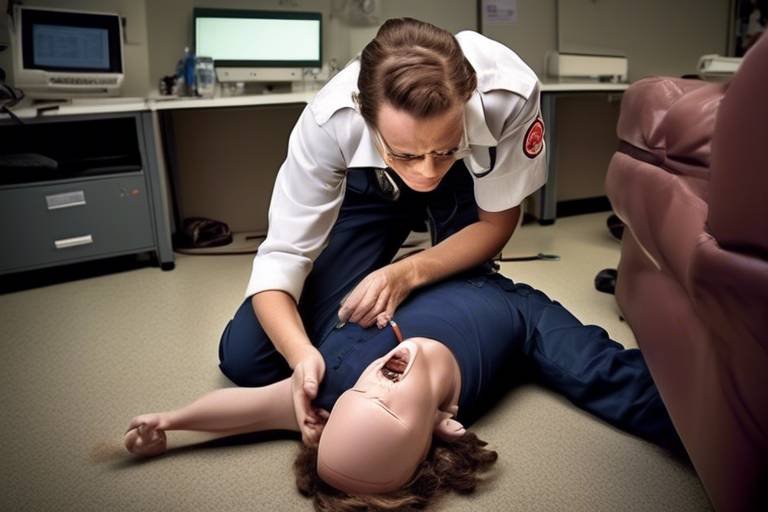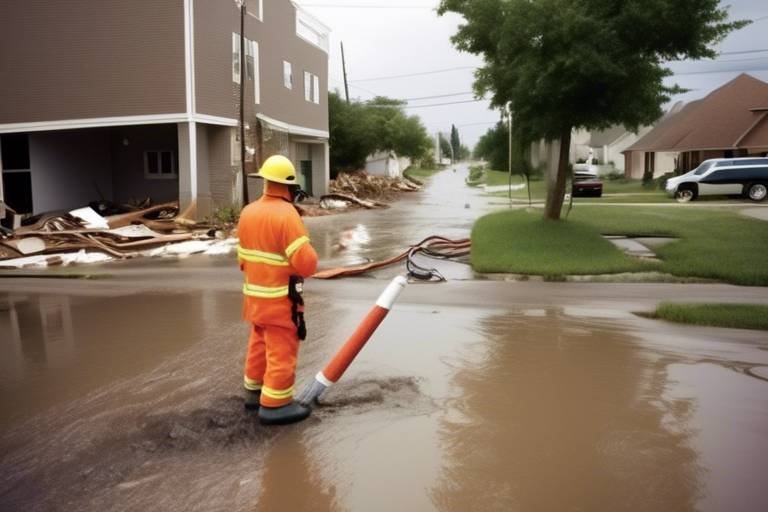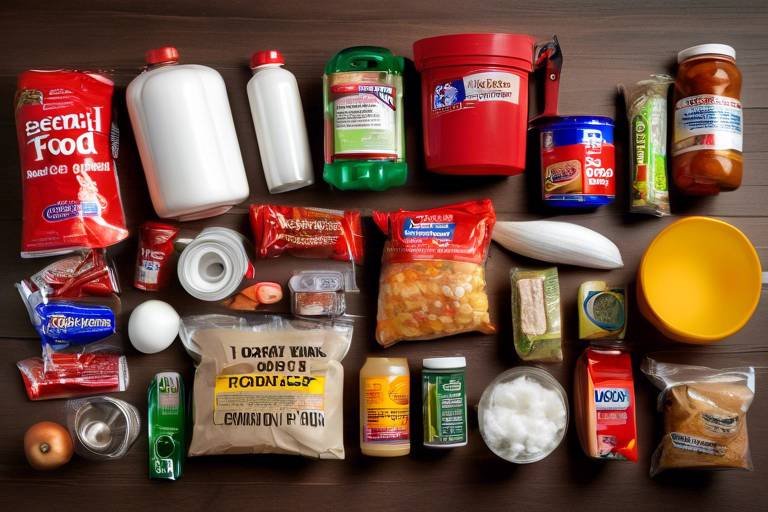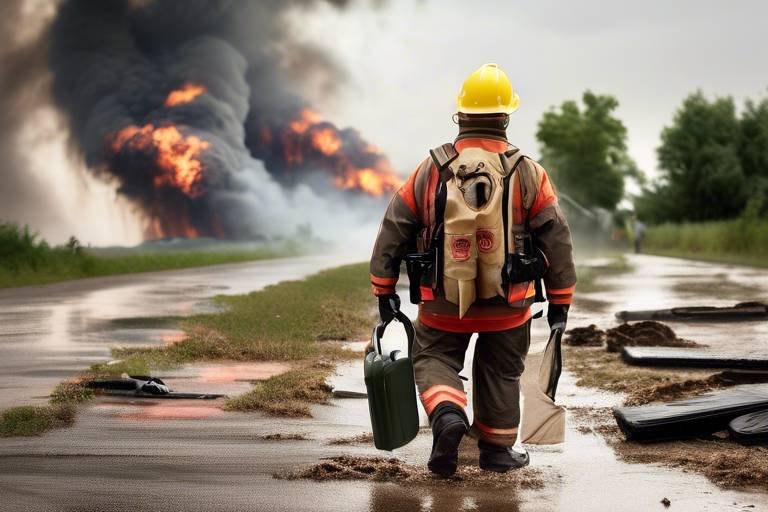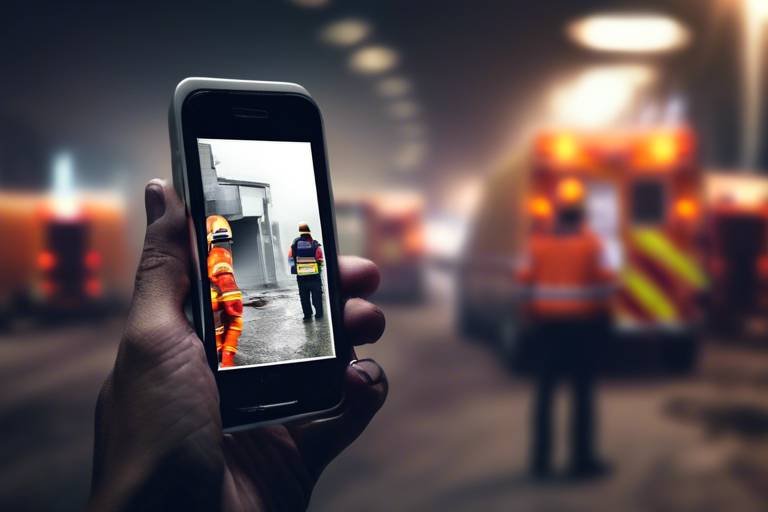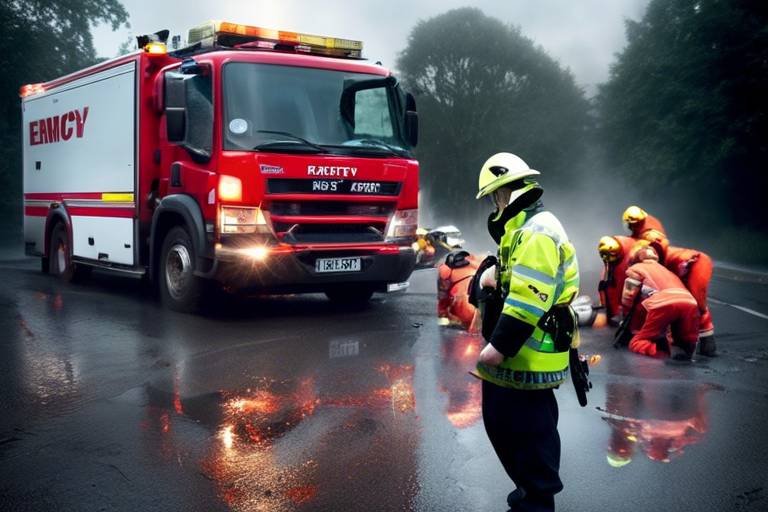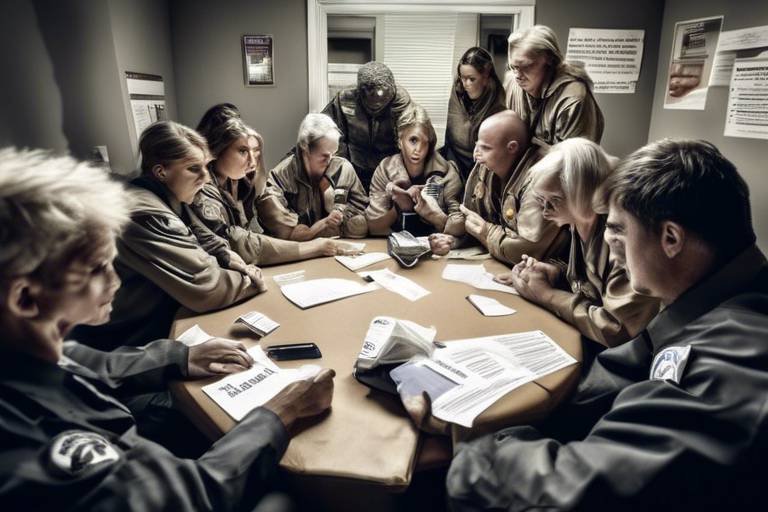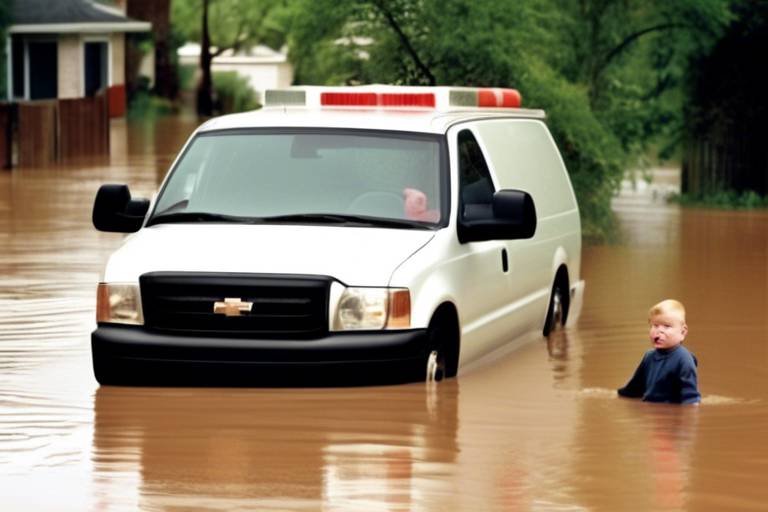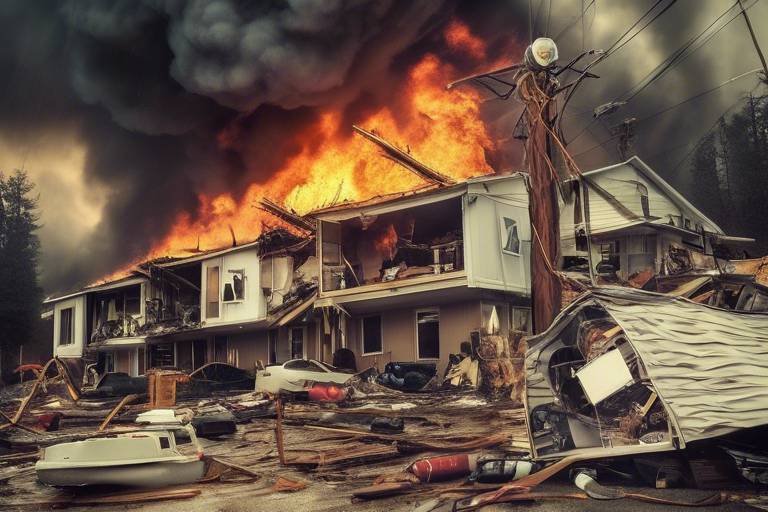How to Keep Your Pet Safe During an Emergency
When disaster strikes, our minds race with thoughts of safety, survival, and the well-being of our loved ones. But let’s not forget about our furry friends! Just like us, pets can feel the stress and confusion that comes with emergencies. Whether it’s a natural disaster, a sudden power outage, or an unexpected situation, being prepared can make all the difference. This article provides essential tips and strategies for ensuring the safety and well-being of your pets during various emergencies.
Emergency preparedness is not just a buzzword; it’s a vital part of responsible pet ownership. Understanding potential risks—like floods, fires, or severe weather—allows you to create a solid plan for your pets. Think of it as a safety net that you can rely on when the unexpected happens. Just as you wouldn’t leave your house without a backup plan, your pets deserve the same consideration. By being proactive, you can safeguard your pets from harm and ensure they remain calm during chaotic times.
An emergency kit is your pet's lifeline during a crisis. It’s like a treasure chest filled with everything your furry friend needs to stay safe and comfortable. But what exactly should be in this kit? Tailoring it to your pet's specific needs is crucial. Consider their size, breed, and any medical requirements they may have. Here’s a quick rundown of essential items to include:
- Food and Water Supplies
- Identification and Microchipping
- First Aid Kit
- Comfort Items (like their favorite blanket or toy)
- Medications (if applicable)
Ensuring your pet has enough food and water during an emergency is crucial. Imagine being in a stressful situation and your pet is hungry or thirsty; it can add to the chaos. To pack and store these supplies effectively, consider the following:
- Store at least a week's worth of food in airtight containers.
- Rotate food supplies periodically to ensure freshness.
- Keep a portable water bowl handy.
Selecting the appropriate type of food for your pet is important. Look for options that are long-lasting, nutritious, and easy to store. Canned food or vacuum-sealed dry food can be excellent choices. They not only provide essential nutrients but also have a longer shelf life. Remember, your pet’s diet should remain consistent, even in emergencies.
Proper water storage is essential for your pet's hydration. You can’t just rely on the tap when the power goes out! Fill clean containers with water and store them in a cool, dark place. It’s also smart to have a portable water filtration system on hand, just in case. Your pet’s health depends on their hydration, so don’t overlook this critical aspect.
In case you get separated from your pet, identification is key. Imagine the panic of losing your furry friend during a chaotic situation! To prevent this, ensure your pet wears a collar with an ID tag that includes your contact information. Additionally, microchipping is a permanent solution that can significantly increase the chances of reuniting with your pet. It’s a small price to pay for peace of mind!
An evacuation plan is crucial for emergencies. Think of it as your roadmap to safety. You wouldn’t drive without a GPS, so why would you head into an emergency without a plan? Start by identifying safe locations for evacuation. Research pet-friendly shelters and accommodations ahead of time. This way, you won’t be scrambling last minute, which can lead to confusion and stress.
Identifying safe locations for evacuation is vital. Not all shelters accept pets, so it’s essential to know your options. Look for local organizations that provide resources for pet-friendly accommodations during emergencies. Having this information at your fingertips can save you time and worry when you need it most.
Practicing your evacuation plan ensures readiness. Just like a fire drill at school, rehearsing your plan with your pet can help reduce stress during an actual emergency. Get your pet used to their carrier, practice loading them in the car, and make sure they’re comfortable with the process. The more familiar they are with the plan, the calmer they’ll be when it counts.
Staying informed about emergency situations is essential for safety. In today’s world, information is power. Utilize technology to keep yourself updated on local emergencies. There are numerous apps and tools available that provide real-time updates. Additionally, engage with community resources that can enhance your preparedness. Local organizations often have programs and services that support pet safety during emergencies.
Technology can play a significant role in keeping you informed. From weather apps to emergency alerts, having the right tools can make all the difference. Set up notifications on your phone to receive updates about local emergencies, ensuring you’re always in the loop.
Engaging with community resources can enhance your preparedness. Local animal shelters and organizations often provide valuable information and support during emergencies. Don’t hesitate to reach out and ask for guidance; they’re there to help!
After an emergency, your pet may need extra care. Just like us, they can experience stress and anxiety in the aftermath. Take the time to assess your pet's well-being and provide the necessary support for recovery. This might include a visit to the vet, extra cuddles, or simply allowing them to adjust back to their routine. Remember, your reassurance can go a long way in helping your furry friend feel safe again.
Q: What should I include in my pet's emergency kit?
A: Include food, water, medications, identification, a first aid kit, and comfort items like toys or blankets.
Q: How often should I update my emergency kit?
A: It's a good idea to check your emergency kit every six months to rotate food and ensure all items are in good condition.
Q: What if I can't find a pet-friendly shelter during an evacuation?
A: Research ahead of time and have a list of pet-friendly hotels or friends' homes who can accommodate your pet.
Q: How can I help my pet cope with stress during emergencies?
A: Provide comfort items, maintain a calm demeanor, and spend extra time with them to help ease their anxiety.

Understanding Emergency Preparedness
When it comes to the safety of our beloved pets, understanding emergency preparedness is not just a good idea—it's a necessity. Emergencies can strike without warning, whether it’s a natural disaster like a hurricane or a sudden household crisis. Just like you would prepare your family, your furry friends deserve the same level of attention and planning. Think of it as having a safety net; it’s always better to be prepared than to scramble at the last minute.
Being proactive means recognizing potential risks in your area. For instance, if you live in a region prone to flooding, you need to have a plan that considers how to keep your pet safe during such events. Similarly, if wildfires are common, knowing safe routes and having evacuation plans in place is crucial. It’s not just about having a plan—it's about having a comprehensive strategy that includes your pets in every step of the way.
One of the first steps in emergency preparedness is to assess your specific situation. Ask yourself questions like:
- What types of emergencies are most likely to occur in my area?
- How will I transport my pet during an evacuation?
- Do I have a list of pet-friendly shelters nearby?
Once you have a grasp on potential emergencies, the next step is to create a detailed plan. This plan should not only outline what to do in various scenarios but also include specific roles for each family member. For example, designate one person to handle the pet's emergency kit while another focuses on gathering important documents. This teamwork can make a significant difference in the chaos of an emergency.
Moreover, it’s essential to keep your plan flexible. As situations change, so should your strategies. Regularly review and update your emergency plan to ensure it reflects your current circumstances. This might include changes in your pet's health, the addition of new pets to your family, or even moving to a new location. Think of it like tuning a musical instrument; regular adjustments keep everything in harmony.
In summary, understanding emergency preparedness involves a proactive approach that considers various scenarios, assesses risks, and creates a flexible, inclusive plan. By taking these steps, you can ensure that your pet remains safe and secure, no matter what challenges arise. Remember, in times of crisis, a well-thought-out plan can be the difference between chaos and calm.

Creating an Emergency Kit
When it comes to protecting your furry friends during emergencies, having a well-thought-out emergency kit can make all the difference. Imagine being in the middle of a crisis, and you can’t find your pet’s essentials. It’s a nightmare! By preparing an emergency kit in advance, you’re not just being proactive; you’re showing your pets that you care. So, what should you include in this kit? Let’s dive into the essentials!
Your emergency kit should cater to your pet's specific needs. Start with the basics, which include food, water, and medical supplies. But don’t stop there! Think about your pet's unique characteristics. For instance, if you have a dog that requires medication for a chronic condition, make sure to include enough of that medication to last at least a week. It's always better to have a little extra than to run out at the worst possible moment!
Here’s a quick rundown of items to consider for your pet’s emergency kit:
- Food and Water: Pack at least a week's worth of food and water. Choose non-perishable options that your pet enjoys.
- Medical Supplies: Include any medications, a first-aid kit, and copies of your pet’s medical records.
- Comfort Items: Bring along your pet’s favorite blanket or toy. This can provide comfort during stressful times.
- Leash and Carrier: Have a sturdy leash and a comfortable carrier ready for quick evacuations.
Now, let’s talk about food and water supplies in more detail. It’s crucial to pack enough food that won’t spoil. Look for options that are high in nutrients and can be stored easily. For dogs, kibble is often a great choice, while cats may prefer canned food. Just remember to rotate the food every few months to ensure freshness! As for water, you should aim for at least a gallon per pet per day. Store it in a clean, durable container to avoid leaks and contamination.
Additionally, consider creating a table like the one below to help you keep track of your emergency kit items:
| Item | Quantity | Notes |
|---|---|---|
| Dry Pet Food | 7 days worth | Rotate every 3 months |
| Canned Food | 7 cans | Check expiration dates |
| Water | 7 gallons | Store in a cool place |
| First Aid Kit | 1 kit | Include pet-specific items |
Finally, don’t forget about identification and microchipping. In the chaos of an emergency, pets can easily become lost. Ensure that your pet's identification tags are up-to-date and that they are microchipped. This small step can significantly increase the chances of being reunited with your beloved companion.
In summary, creating an emergency kit for your pet is not just about gathering supplies; it’s about ensuring their safety and well-being. By taking the time to prepare, you can face any emergency with confidence, knowing that your furry family member is well taken care of.

Food and Water Supplies
When it comes to keeping your furry friends safe during an emergency, are the cornerstones of your preparedness plan. Imagine being caught in a natural disaster, and you suddenly realize that your pet's food supply is running low. Not a pleasant thought, right? That's why it’s crucial to have a well-thought-out strategy for stocking up on essentials. First things first, you need to determine how much food and water your pet will need. A general rule of thumb is to have at least a 72-hour supply of food and water for each pet in your household. This means if you have a dog, you’ll need to calculate their daily intake and multiply it by three.
Next, consider the type of food that will last the longest and provide the necessary nutrients. Canned food is a great option because it has a long shelf life and is typically more palatable for pets. However, dry kibble can also be a good choice, especially if you store it in a sealed container to keep it fresh. Remember, pets can be picky eaters, so it might be wise to include a few of their favorite treats in your emergency kit as well. Not only can this help keep their spirits up during stressful times, but it can also serve as a great motivator when you need to coax them into a carrier or vehicle.
Water is equally important, and you should plan for at least one gallon of water per pet per day. This is where things can get a bit tricky, especially if you have multiple pets. To make things easier, consider storing water in 5-gallon containers or smaller bottles that are easy to transport. If you have the space, a water purification system can also be a lifesaver. In an emergency, you might find yourself in a situation where clean water isn’t readily available, and having a way to purify water can make a world of difference. Remember to rotate your water supply every six months to ensure it stays fresh.
To help you visualize your pet's food and water supply needs, here’s a simple table:
| Pet Type | Daily Food Requirement (lbs) | Emergency Food Supply (lbs for 3 days) | Daily Water Requirement (gallons) | Emergency Water Supply (gallons for 3 days) |
|---|---|---|---|---|
| Dog (50 lbs) | 2.5 | 7.5 | 0.5 | 1.5 |
| Cat (10 lbs) | 0.5 | 1.5 | 0.2 | 0.6 |
| Small Dog (15 lbs) | 0.75 | 2.25 | 0.2 | 0.6 |
To sum it all up, having a comprehensive plan for your pet's food and water supplies can make the difference between comfort and chaos during an emergency. Make your preparations now, and you’ll have peace of mind knowing that your beloved companions will be well taken care of, no matter what happens. After all, they depend on us to keep them safe, and being prepared is a significant part of that responsibility.
- How much food should I store for my pet? Aim for at least a 72-hour supply, adjusting based on your pet's size and dietary needs.
- Can I use regular tap water for my pet during emergencies? Yes, but ensure you have a way to purify it if necessary.
- What type of food lasts the longest? Canned food typically has a longer shelf life than dry food, but both can be effective if stored properly.
- How often should I rotate my emergency supplies? Rotate your food and water supplies every six months to keep them fresh.

Choosing the Right Food
When it comes to ensuring your furry friend is well-fed during an emergency, is paramount. You want to make sure that you have enough supplies that not only keep them full but also provide the necessary nutrients. Think of it like packing for a long road trip; you wouldn’t just throw in a bunch of snacks without considering whether they’re healthy or filling, right? The same principle applies to your pet's emergency food supply.
First off, consider your pet's dietary needs. Different pets have different requirements based on their age, weight, and health conditions. For instance, puppies and kittens require more protein and calories than adult pets. If your pet has specific dietary restrictions, such as allergies or medical conditions, it's crucial to take those into account when selecting food. You wouldn’t want to pack something that could upset their stomach or worse, cause a health crisis during a time when vet access might be limited.
Next, focus on long-lasting options. Canned food can be a great choice because it has a longer shelf life and is often more palatable for pets. However, dry kibble is another excellent option, as it’s lightweight and easy to store. Here’s a quick comparison:
| Type of Food | Shelf Life | Storage | Palatability |
|---|---|---|---|
| Canned Food | 2-5 years | Cool, dry place | High |
| Dry Kibble | 1-2 years | Cool, dry place | Moderate to High |
Moreover, don’t forget to include some treats in your emergency kit. Treats can serve multiple purposes: they can be a source of comfort for your pet during stressful times, help in training them to follow your commands, and even act as a reward for good behavior. Just ensure that the treats are also safe and appropriate for your pet’s dietary needs.
Lastly, consider how you’ll prepare and serve the food. If you’re using canned food, make sure to have a manual can opener handy, as power outages can render electric openers useless. For dry food, a sealed container is essential to keep it fresh and safe from pests. And don’t forget about the water—it’s just as important as food. Always have enough water to last at least a few days, and remember to change it regularly to keep it fresh.
In summary, making informed decisions about your pet's food can significantly impact their well-being during an emergency. By considering their specific needs, choosing long-lasting options, and ensuring proper storage and serving methods, you can help your pet stay nourished and healthy, no matter what challenges arise.

Water Storage Tips
When it comes to keeping your furry friends hydrated during an emergency, proper water storage is absolutely essential. Just like humans, pets need access to clean and safe drinking water, especially in times of crisis. But how do you ensure that your pet's water supply is both adequate and easily accessible? Let's dive into some practical tips that will help you store water effectively for your pets.
First and foremost, it's important to understand how much water your pet will need. A good rule of thumb is to provide at least one ounce of water per pound of body weight each day. For example, if you have a 20-pound dog, you should aim for at least 20 ounces of water daily. In an emergency, it's wise to store enough water for at least three to seven days. Here’s a quick breakdown of how much water you might need based on your pet's weight:
| Pet Weight (lbs) | Water Needed (oz/day) | Water Needed (gallons/7 days) |
|---|---|---|
| 10 | 10 | 0.6 |
| 20 | 20 | 1.2 |
| 40 | 40 | 2.4 |
| 60 | 60 | 3.6 |
Now that you know how much water to store, let's talk about the best ways to store it. One of the simplest solutions is to use food-grade plastic containers. These containers are durable and won't leach harmful chemicals into the water. Make sure to label each container clearly with the date it was filled, so you can rotate your supply and keep it fresh. Additionally, consider using water purification tablets or filters to ensure that the water remains safe for your pets to drink, especially if you're storing it for an extended period.
Another important tip is to keep your stored water in a cool, dark location. Exposure to sunlight can promote algae growth and degrade the quality of the water. If possible, store your containers in a basement or a shaded area of your home. Also, remember to check your water supply regularly. A quick visual inspection can help you catch any signs of contamination or leaks before they become a bigger issue.
Lastly, don't forget about the accessibility of the water. Make sure that the containers are easy to reach, especially if you have to evacuate quickly. You might want to keep a smaller, portable water container in your emergency kit that you can grab and go. This way, you can ensure that your pet has immediate access to water, even in the chaos of an emergency.
By following these tips, you'll be well on your way to ensuring that your pet stays hydrated and healthy, even during the most challenging situations. Remember, being prepared is the best way to keep your beloved pets safe!
- How much water should I store for my pet? Aim for at least one ounce of water per pound of your pet’s weight each day, with a minimum of three to seven days’ worth stored.
- Can I use regular containers for water storage? It's best to use food-grade plastic containers to avoid leaching harmful chemicals.
- How often should I check my water supply? Regularly inspect your water supply at least once a month to ensure it remains clean and safe.
- What should I do if my stored water looks cloudy? If you notice cloudiness or any signs of contamination, discard the water and refill your containers with fresh water.

Identification and Microchipping
In the whirlwind of an emergency, the last thing you want is to be separated from your beloved pet. Imagine the panic and uncertainty that would wash over you if you couldn't find them amidst the chaos. That's where proper identification and microchipping come into play. These are not just optional extras; they are essential lifelines that can ensure your furry friend finds their way back to you.
First and foremost, let's talk about identification tags. Every pet should wear a collar with a tag that includes their name, your name, and a contact number. This simple step can make a world of difference. Think of it as a safety net; it’s a quick way for someone to help reunite you with your pet. However, collars can slip off or get lost, especially in stressful situations. That's why microchipping is an absolute game-changer.
Microchipping involves implanting a tiny chip, about the size of a grain of rice, under your pet's skin. This chip contains a unique identification number that is linked to your contact information in a database. If your pet ends up in a shelter or with a vet, they can be scanned, and just like that, you’re back in touch! It’s like giving your pet a permanent ID card that never leaves their side.
But how does one go about getting a microchip? The process is straightforward and quick. Most veterinarians and animal shelters offer microchipping services. It’s a simple procedure that can usually be done during a routine check-up. Just a quick pinch, and your pet is now part of a global recovery network. Plus, it’s a one-time cost that can save you from heartache in the long run.
It’s important to keep your information updated in the microchip database. If you move or change your phone number, make sure to update those details. Otherwise, that little chip won’t do you much good if it can’t lead someone back to you!
In summary, ensuring your pet's safety during an emergency is about more than just love and care; it’s about preparation. By investing in proper identification and microchipping, you’re giving yourself peace of mind. You’re not just hoping for the best; you’re actively taking steps to ensure that, no matter what happens, your pet has a way home. So, take a moment today to check your pet's collar and consider microchipping if you haven’t done so already. Trust me, it’s a decision you won’t regret!

Developing an Evacuation Plan
When it comes to emergencies, having a well-thought-out evacuation plan can mean the difference between safety and chaos. Just like you wouldn't jump into a car without knowing where you're headed, you shouldn't wait until a disaster strikes to figure out how to keep your furry friends safe. Developing an evacuation plan for your pets is crucial, and it starts with understanding your unique situation and the potential risks in your area. Whether it's a hurricane, wildfire, or even a sudden flood, being prepared can help you respond quickly and effectively.
First things first, identify safe locations. This means finding pet-friendly shelters, hotels, or homes of friends and family where you can take your pets in case of an emergency. Not all shelters allow pets, so do your homework ahead of time. You can create a simple table to keep track of these locations, including their contact information and any specific pet policies they may have:
| Location Name | Address | Contact Number | Pet Policy |
|---|---|---|---|
| Local Shelter | 123 Main St, Anytown | (555) 123-4567 | Pets Allowed |
| Friend's House | 456 Elm St, Anytown | (555) 987-6543 | Pets Allowed |
| Pet-Friendly Hotel | 789 Oak St, Anytown | (555) 555-5555 | Pets Allowed with Fee |
Next, think about how you will transport your pets. Do you have a sturdy carrier for each pet? If not, now's the time to invest in one. Make sure your pets are comfortable with their carriers so that they don't feel stressed when it's time to evacuate. You might also want to consider a leash and harness for dogs, as well as a sturdy collar with ID tags that have your contact information. Remember, in the chaos of an emergency, pets can easily become disoriented and scared.
Once you've identified your safe locations and transportation methods, it's time to practice your plan. Yes, you heard that right—practice! Just like fire drills in school, rehearsing your evacuation plan with your pets will help them become familiar with the process. This can significantly reduce their stress levels during an actual emergency. Try to simulate various scenarios, such as what you would do if you had to leave in a hurry or if you had to stay in a shelter for an extended period. The more prepared you are, the more confident you'll feel.
Finally, keep your evacuation plan updated. As life changes—like moving to a new home or adding a new pet to your family—your plan should evolve too. Regularly check your emergency kit, update your list of safe locations, and ensure that your pets' ID tags and microchip information are current. This ongoing vigilance will ensure that you and your pets are always ready, no matter what happens.
- What should I include in my pet's evacuation kit? Essential items include food, water, medications, a leash, a carrier, and a first aid kit.
- How can I help my pet feel more comfortable during an evacuation? Familiarize your pet with their carrier and practice the evacuation plan regularly.
- Are there specific shelters that accept pets during emergencies? Yes, research and compile a list of pet-friendly shelters in your area before an emergency occurs.
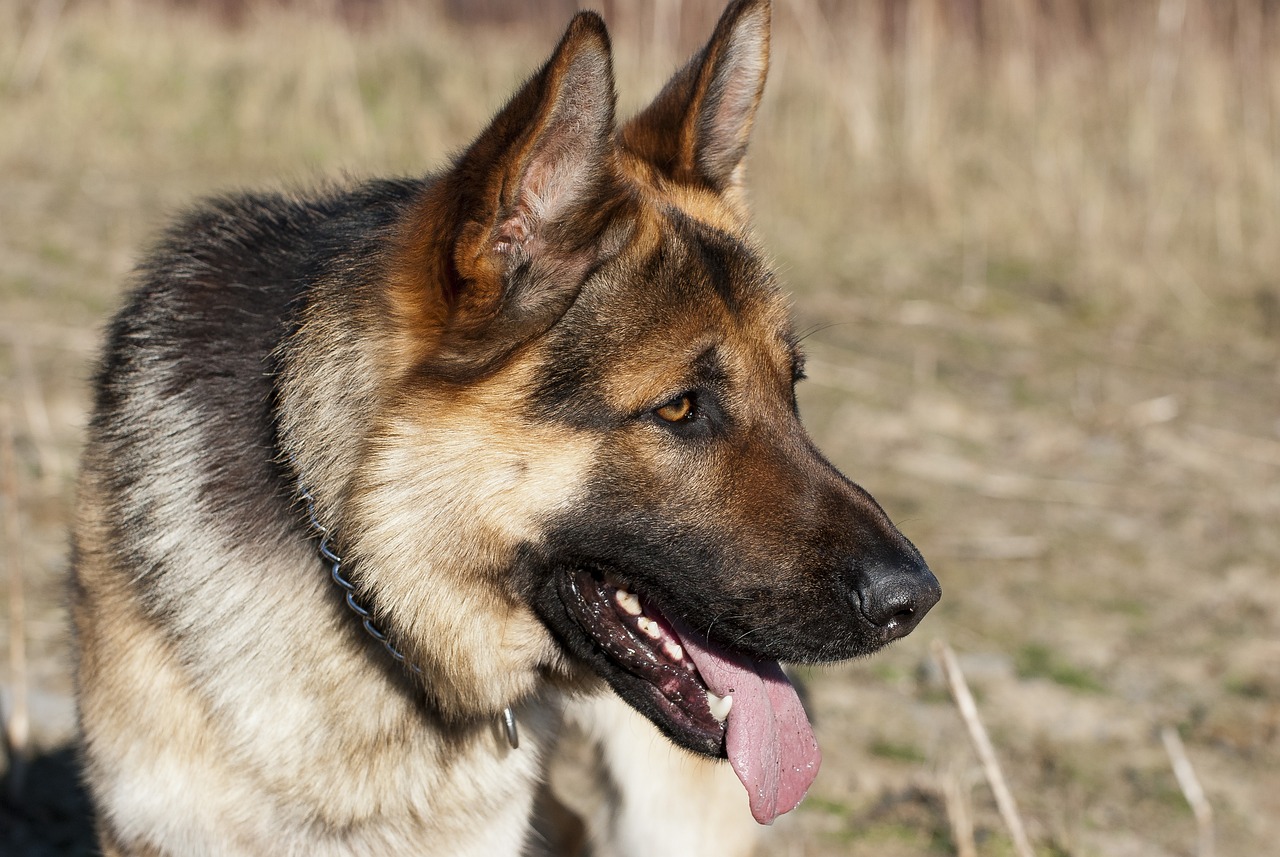
Choosing Safe Locations
When disaster strikes, one of the most critical steps you can take is to identify safe locations for you and your furry friend. It's like preparing a backup plan for your backup plan! Not all shelters or accommodations are pet-friendly, so knowing where you can go is essential. First, start by researching local shelters that allow pets. Many communities have designated emergency shelters that welcome animals, especially during natural disasters. Websites like Ready.gov provide a wealth of information on how to find these resources.
Next, consider reaching out to local hotels or motels that are known to be pet-friendly. It’s wise to have a list of these places handy, just in case you need to evacuate quickly. Some places even offer special rates for evacuees with pets. You can call ahead to confirm their policies and ensure they can accommodate your furry companion. It’s a good idea to keep a list of these locations in your emergency kit, along with their contact information, so you can access it easily in a panic.
Additionally, think about friends or family members who might be willing to take you and your pet in during an emergency. Having a personal network can be a lifesaver. Make sure to discuss this plan with them ahead of time, so they know what to expect. You wouldn’t want to show up unannounced with a four-legged friend in tow!
Lastly, don't forget to check for local community resources that may offer temporary housing or foster care for pets during emergencies. Organizations like the ASPCA and local animal shelters often have programs in place to help pet owners in distress. Their websites can provide invaluable information on available resources in your area.
In summary, preparing a list of potential safe locations for you and your pet can make all the difference when time is of the essence. Make sure to include:
- Pet-friendly emergency shelters
- Local hotels and motels
- Friends and family who can help
- Community resources and organizations
By taking the time to plan ahead, you can ensure that you and your beloved pet stay safe and secure during any emergency situation.
Q: What should I do if I can't find a pet-friendly shelter?
A: If you can't find a pet-friendly shelter, consider reaching out to friends or family who may take you in or look for nearby hotels that allow pets. Additionally, local animal shelters may have resources or recommendations for pet-friendly accommodations.
Q: How can I prepare my pet for an evacuation?
A: Get your pet used to their carrier or travel crate before an emergency arises. Practice short trips in the car and ensure they are comfortable being handled. This will help reduce stress during an actual evacuation.
Q: What if my pet gets lost during an emergency?
A: Always ensure your pet has proper identification, including a collar with tags and a microchip. If they do go missing, contact local shelters and use social media to spread the word.
Q: Are there any specific supplies I should pack for my pet during an emergency?
A: Yes! Pack enough food and water for at least three days, medications, a first-aid kit, and comfort items like toys or blankets. Don't forget a leash and waste disposal bags!
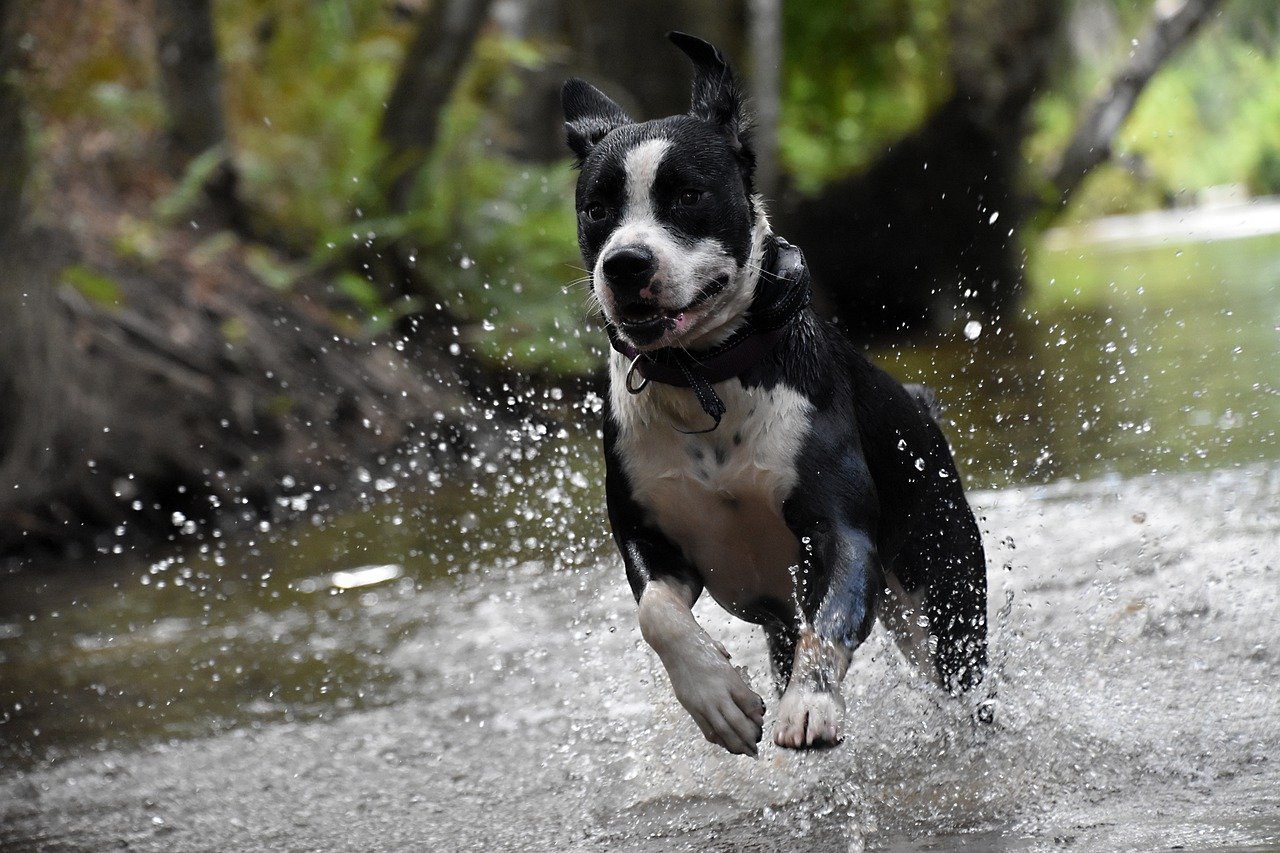
Practicing the Plan
When it comes to ensuring your pet's safety during an emergency, simply having an evacuation plan is not enough. You need to practice the plan regularly to ensure that both you and your furry friend are well-prepared for any unexpected situation. Think of it like a fire drill at school; the more you practice, the more instinctive your reactions become. Have you ever noticed how children can recite their emergency procedures without a second thought? That's the goal you want to achieve with your pet!
Start by walking through the steps of your evacuation plan with your pet. This includes getting your pet used to their carrier or leash, as these will be essential during an actual emergency. You can make this practice session enjoyable by incorporating treats or toys, which will help your pet associate the experience with positive feelings. It’s all about creating a stress-free environment that fosters familiarity and comfort.
In addition to practicing the physical aspects of the plan, it’s also important to simulate various scenarios. For instance, what would you do if you had to evacuate quickly? You might want to set a timer and see how fast you can gather your emergency kit, leash your pet, and exit your home. This not only helps you gauge your readiness but also teaches your pet to remain calm under pressure. Remember, a panicked owner can lead to a panicked pet, so your demeanor during practice is crucial.
Consider practicing in different environments too. If you have a yard, practice there, then try it inside your home, and finally, venture out to a nearby park. This way, your pet becomes accustomed to the idea of evacuation in various settings, making them less likely to be overwhelmed during a real emergency. You might even want to involve family members or friends in these drills, making it a fun group activity while reinforcing the importance of safety.
Finally, keep in mind that pets can pick up on our emotions. If you’re anxious or stressed during practice, your pet might feel the same way. So, maintain a calm and positive attitude throughout the exercises. To help you keep track of your practice sessions, consider creating a simple
| Date | Scenario Practiced | Duration | Notes |
|---|---|---|---|
| MM/DD/YYYY | Indoor Evacuation | 10 minutes | Pet was calm; need to practice with carrier. |
| MM/DD/YYYY | Outdoor Evacuation | 15 minutes | Pet responded well; added distractions. |
By consistently practicing your evacuation plan, you’re not only preparing for emergencies but also building a stronger bond with your pet. Remember, the goal is to ensure that both you and your pet feel confident and ready to tackle any situation that may arise. So go ahead, grab that leash, and start practicing today!
Q: How often should I practice my evacuation plan with my pet?
A: It’s a good idea to practice at least once a month. This keeps the plan fresh in both your and your pet’s minds.
Q: What if my pet is anxious during practice sessions?
A: If your pet shows signs of anxiety, take a step back and try to make the practice more enjoyable. Use treats and toys to create positive associations.
Q: Should I involve my family in the practice sessions?
A: Absolutely! Involving family members not only makes it more fun but also ensures everyone knows their role during an emergency.
Q: Can I use technology to help with my evacuation plan?
A: Yes! There are several apps available that can assist you in planning and practicing your evacuation strategy.
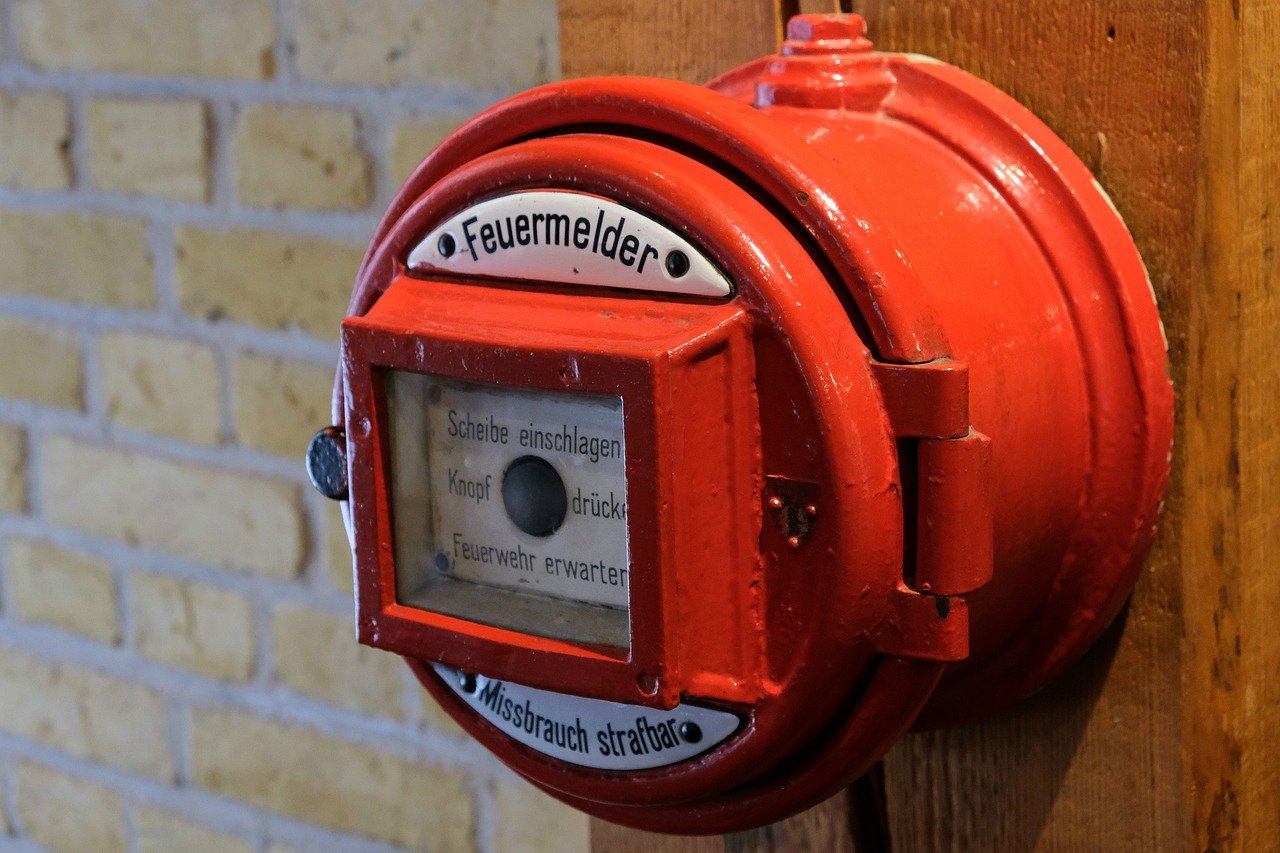
Staying Informed During Emergencies
When it comes to keeping your pets safe during emergencies, one of the most crucial elements is staying informed. Imagine being in the middle of a storm or an unexpected evacuation; the last thing you want is to be caught off guard without knowing what's happening around you. Staying updated not only helps you make timely decisions but also ensures that you can take the necessary steps to protect your furry friends. So, how do you stay in the loop when chaos strikes?
First off, it’s vital to have reliable sources of information at your fingertips. Local news stations, weather apps, and emergency management websites can provide real-time updates about unfolding situations in your area. Consider downloading a few trusted apps that send alerts directly to your phone. These can serve as your lifeline, keeping you aware of any threats that could affect your pet's safety. Here are some recommended apps:
- FEMA App: Offers alerts and safety tips tailored to your region.
- Weather Underground: Provides hyper-local weather updates.
- Nextdoor: A community-based app where neighbors share information about local emergencies.
Additionally, having a battery-operated or hand-crank radio can be a game-changer. In case of power outages, this device can keep you connected to emergency broadcasts. It’s like having a direct line to the world, even when everything else goes dark. Just make sure to keep extra batteries on hand!
Social media can also be a double-edged sword during emergencies. While it can be a great way to get quick updates, misinformation can spread just as fast. Always cross-reference information you find on social platforms with credible news sources. Think of social media as a bustling marketplace—amidst the noise, you need to find the trustworthy vendors.
Engaging with local community resources is another effective way to stay informed. Many towns and cities have dedicated pages or groups on platforms like Facebook where residents share real-time updates and tips during emergencies. Not only can you get valuable information, but you can also connect with other pet owners who might have insights specific to your area. It’s like forming a neighborhood watch, but for your pets!
In addition to these resources, consider joining local pet safety groups or forums. These communities often share best practices and can alert you to pet-friendly shelters or services that might be available during emergencies. It’s always better to have a network of fellow pet lovers who are just as concerned about their furry companions as you are.
Lastly, don’t underestimate the power of preparation. By having a plan in place and knowing where to find information, you’ll feel more in control when emergencies arise. Think of it as training for a marathon—when the race day comes, you’ll be ready to run, no matter the obstacles in your path. Stay informed, stay prepared, and ensure your pets are safe, no matter what comes your way.
Q: What should I do if I can't find my pet during an emergency?
A: First, remain calm and retrace your steps. Check safe hiding spots around your home and ask neighbors for help. Use social media to alert the community about your lost pet.
Q: How can I ensure my pet's safety when evacuating?
A: Always have an emergency kit ready, including food, water, and identification. Familiarize your pet with their carrier or leash before an emergency strikes to make the evacuation process smoother.
Q: Are there any specific apps for pet safety during emergencies?
A: Yes! Apps like the FEMA app and local weather services are essential. Additionally, consider pet-specific apps that provide tips and resources during emergencies.

Utilizing Technology
In today's fast-paced world, technology can be a game-changer when it comes to keeping your pet safe during emergencies. Imagine having real-time information at your fingertips, allowing you to make quick decisions that could save your furry friend's life. With just a few taps on your smartphone, you can access crucial updates about natural disasters, local emergencies, and even pet-friendly shelters. So, how can you harness the power of technology to ensure your pet's safety? Let's dive into some essential tools and resources.
First off, consider downloading emergency alert apps that provide notifications about severe weather, fires, or other emergencies. These apps often allow you to customize alerts based on your location, so you’ll know exactly when to take action. Some popular choices include:
- FEMA App: Offers emergency preparedness tips, alerts, and safety information.
- Red Cross Emergency App: Provides alerts about disasters in your area, including pet safety information.
- Weather Underground: Gives hyper-local weather forecasts and alerts, perfect for tracking storm developments.
Moreover, social media platforms can also be invaluable during emergencies. Communities often come together to share information about lost pets, available shelters, and even local resources for pet care. By following local animal shelters and rescue organizations on platforms like Facebook and Twitter, you can stay updated on the latest news and emergency resources tailored specifically for pet owners.
Another technological advancement that can significantly enhance your pet's safety is GPS tracking. Imagine being able to locate your pet instantly if they get lost during an evacuation. GPS collars or pet trackers can provide real-time location updates, ensuring you can quickly reunite with your beloved companion. Some popular GPS trackers include:
- Whistle Go Explore: Tracks location and monitors health, allowing you to keep an eye on your pet's well-being.
- Fi Smart Dog Collar: Offers long battery life and real-time tracking, perfect for adventurous pets.
Lastly, don’t underestimate the power of video calls! If you are separated from your pet during an emergency, video calling can help you assess their condition and reassure them until you can reunite. Apps like Zoom or Skype can be useful for this purpose, allowing you to connect with friends or family who may have your pet in their care.
In conclusion, leveraging technology can provide a safety net for you and your pet during emergencies. Whether it's through apps that keep you informed, social media that connects you with your community, GPS trackers that help locate your pet, or video calls that offer comfort, being tech-savvy can make all the difference. So, gear up with these technological tools and ensure that you and your pet are well-prepared for any situation that may arise!
Q1: What should I do if I get separated from my pet during an emergency?
A1: Make sure your pet is microchipped and has an ID tag with your contact information. Use GPS trackers if available, and check local shelters and social media for lost pet postings.
Q2: How can I ensure my pet is comfortable during an evacuation?
A2: Pack familiar items like their favorite blanket or toy. Also, bring enough food, water, and any necessary medications to keep them comfortable during the evacuation.
Q3: Are there specific apps I should have for emergency preparedness?
A3: Yes! Consider downloading apps like the FEMA app, Red Cross Emergency app, and local weather apps for timely alerts and information.

Community Resources
When it comes to ensuring the safety of your beloved pets during emergencies, tapping into can be a game changer. Local organizations, shelters, and even veterinary clinics often have plans in place to assist pet owners during crises. These resources can provide everything from emergency boarding to temporary shelter for your pets if you need to evacuate your home. So, how do you find these invaluable services? It’s simpler than you might think!
Start by reaching out to your local animal control or humane society. They can offer guidance on pet-friendly shelters and may have lists of resources available in your area. Many communities also have dedicated websites or social media pages that share real-time information during emergencies, including where to find help for pets. For instance, if a natural disaster strikes, local organizations might set up temporary shelters specifically for animals, ensuring that both you and your furry friend have a safe place to stay.
Another excellent resource is your veterinarian. They can provide advice on emergency preparedness and may also have connections with local shelters and pet services. Some veterinary clinics even offer emergency care and can guide you on how to best care for your pets in the aftermath of an event. Don't forget to ask them about any community initiatives that support pet safety during emergencies.
Moreover, consider joining local pet owner groups or forums. These platforms can be a treasure trove of information, where fellow pet owners share their experiences and resources. You can learn about local evacuation routes that accommodate pets, as well as any community events aimed at enhancing pet safety. Remember, in times of crisis, the more prepared you are, the better you can protect your pets.
To make things easier, here’s a quick table summarizing some key community resources you should keep in mind:
| Resource Type | Description | Contact Information |
|---|---|---|
| Local Animal Control | Provides information on pet-friendly shelters and emergency services. | [Insert Contact Info] |
| Veterinary Clinics | Offers emergency care and advice on pet safety during crises. | [Insert Contact Info] |
| Humane Societies | May provide temporary shelter and resources for pets during emergencies. | [Insert Contact Info] |
| Community Pet Groups | Connects pet owners for sharing information and resources. | [Insert Contact Info] |
In summary, leveraging community resources can significantly enhance your emergency preparedness. By staying informed and connected, you can ensure that both you and your pets are well taken care of during any unexpected situation. Remember, it’s all about teamwork, and your community can be your greatest ally in keeping your furry companions safe!

Post-Emergency Care for Pets
After an emergency, the well-being of your pet is paramount. Just like us, pets can experience stress and anxiety in the aftermath of a crisis. They may not understand what happened, and this can lead to behavioral changes. It’s crucial to monitor your pet closely for any signs of distress or health issues. Always remember: your furry friend relies on you to ensure their safety and comfort.
First and foremost, take a moment to assess your pet’s physical condition. Look for any injuries, unusual behavior, or signs of illness. If your pet seems lethargic, refuses to eat, or shows signs of distress, it’s essential to consult a veterinarian. Don’t hesitate! Early intervention can make a significant difference in their recovery.
In addition to physical health, consider your pet’s emotional state. Just as humans might feel anxious after a traumatic event, pets can experience similar feelings. Create a calm environment for your pet by providing a safe space where they can retreat and feel secure. This might be a cozy corner with their favorite blanket or a quiet room where they can relax away from the chaos.
Another important aspect of post-emergency care is re-establishing routines. Pets thrive on consistency, so try to return to their regular feeding and walking schedule as soon as possible. This familiar structure can help reduce anxiety and provide a sense of normalcy. Additionally, consider engaging in some light play or exercise to help them release pent-up energy and relieve stress.
It’s also vital to keep an eye on your pet’s nutrition during this recovery phase. If their regular food was damaged or lost during the emergency, ensure you have a suitable replacement. Here’s a quick table to help you understand what to consider when choosing food for your pet post-emergency:
| Criteria | Considerations |
|---|---|
| Type of Food | Opt for high-quality, nutritious options that are easy to digest. |
| Availability | Ensure you have access to enough supplies for at least a week. |
| Hydration | Always provide fresh water; dehydration can be a serious issue. |
Lastly, don’t forget about the importance of reconnecting with your pet. Spend quality time with them, whether it’s through gentle petting, brushing, or simply sitting together. This not only helps them feel loved but also strengthens your bond after a stressful experience.
- What should I do if my pet shows signs of anxiety after an emergency?
Consider consulting a veterinarian for advice on anxiety management techniques or medications. - How can I tell if my pet is injured?
Look for limping, excessive licking of a specific area, or unusual vocalizations. If in doubt, seek veterinary care. - Is it safe to feed my pet different food after an emergency?
While it's best to stick to their regular diet, if you must switch, do it gradually to avoid digestive issues.
Frequently Asked Questions
- What should I include in my pet's emergency kit?
Your pet's emergency kit should include essentials like food, water, medications, a first aid kit, identification tags, and comfort items such as a favorite toy or blanket. Don’t forget to tailor the kit to your pet’s specific needs, like including any special dietary requirements or medical supplies.
- How can I ensure my pet is properly identified?
Make sure your pet wears a collar with an ID tag that includes your contact information. Additionally, consider microchipping your pet, which provides a permanent form of identification. This way, if you get separated, there’s a much better chance of reuniting!
- What steps should I take to create an evacuation plan for my pet?
Start by identifying safe locations that accept pets. Create a list of pet-friendly shelters or hotels in advance. Practice the plan with your pet so they become familiar with the routine. This preparation can help reduce stress during an actual emergency.
- How can I stay informed about emergencies in my area?
Utilize technology by downloading apps that provide real-time updates on emergencies. Follow local news outlets on social media and sign up for community alerts. Staying informed can help you make timely decisions for your pet's safety.
- What should I do to care for my pet after an emergency?
After an emergency, assess your pet for any injuries and provide a calm environment. They may need extra care and reassurance as they recover. Monitor their behavior and health closely, and consult a veterinarian if you notice any concerning changes.


